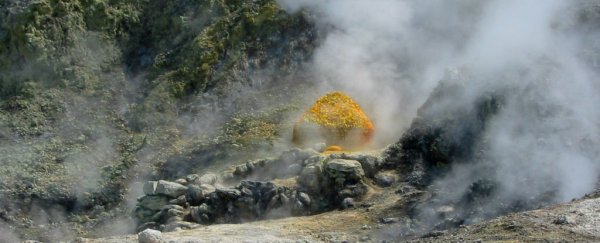A 12-km wide cauldron that forms a vast supervolcano on the coast of Italy is showing signs of reawakening after almost 500 years of inactivity.
Not only is this site rumoured to be responsible for the extinction of the Neanderthals, it's got 500,000 people living around it right now, and researchers say it appears to be approaching a critical pressure point that could lead to an eruption.
You might imagine a supervolcano as like a regular volcano, only supersized, rising up out of the ground and puffing whirls of menacing smoke from its gaping maw.
But in reality, supervolcanos are extensive fields of volcanic activity, formed when a volcano ejects so much magma from its centre, it collapses in on itself, leaving behind a vast crater, and a landscape littered with geysers, hydrothermal activity, and sulphuric acid.
Think Yellowstone, where lava eruptions and swelling steam vents make up a constantly bubbling, otherworldly landscape.
Campi Flegrei - or "burning fields" in Italian - is another extensive volcanic area, located to the west of Naples, Italy.
Boasting 24 craters and large volcanic edifices, mostly hidden under the Mediterranean Sea, this ancient 'caldera' - or cauldron-like depression - formed 39,000 years ago, as part of the biggest eruption Europe has seen in the past 200,000 years.
Since its formation, Campi Flegrei has only had two major eruptions - 35,000 years ago and 12,000 years ago - and a smaller eruption that occurred in 1538.
But when we say "smaller", it's all relative, because the 1538 eruption lasted for eight days straight, and spewed so much material into the surrounding area, it formed a new mountain, Monte Nuovo.
It's the whole site that's a concern though - the eruption that occurred 200,000 years ago is thought to have been so cataclysmic, a 2010 study suggests that it triggered a 'volcanic winter', that ultimately led to the extinction of the Neanderthals.
While the connection of the demise of the Neanderthals remains purely speculative until further evidence can be found, the eruption, which is thought to have spewed almost 1 trillion gallons (3.7 trillion litres) of molten rock onto the surface - along and with just as much sulphur into the atmosphere - is not.
"These areas can give rise to the only eruptions that can have global catastrophic effects comparable to major meteorite impacts," Giuseppe De Natale from Italy's National Institute for Geophysics and Volcanology, told Reuters back in 2012.
Now a team led by volcanologist Giovanni Chiodini from the Italian National Institute of Geophysics in Rome reports that Campi Flegrei appears to be approaching a critical pressure point that could trigger another eruption.
This critical pressure point - referred to as critical degassing pressure (CDP) - could drive volcanic unrest towards a critical state, the team reports, by releasing jets of super-hot gas into the atmosphere, heating the surrounding hydrothermal fluids and rocks, and causing rock failure and possibly an eruption.
"Hydrothermal rocks, if heated, can ultimately lose their mechanical resistance, causing an acceleration towards critical conditions," Chiodini told the AFP.
Over the past decade, Campi Flegrei has be experiencing an 'uplift', which suggests that the volatile gases beneath it are rising to the surface at an accelerating rate.
In response to this uplift, Italy raised the supervolcano's alert level from green to yellow - or from "quiet" to "requires scientific monitoring".
Two other active volcanoes, Rabaul in Papua New Guinea and Sierra Negra in the Galapagos, "both showed acceleration in ground deformation before eruption with a pattern similar to that observed at Campi Flegrei", Chiodini said.
So should the nearby residents panic? Not just yet, because at this stage, it's pretty much impossible to predict what the Campi Flegrei caldera will do - if it does anything at all.
"In general, unfortunately, volcanology is not a precise science," Chiodini told Sarah Kaplan at The Washington Post.
"We have many uncertainties and long-term previsions are at the moment not possible! For example, the process that we describe could evolve in both directions: toward pre-eruptive conditions or to the finish of the volcanic unrest."
The researchers are hoping that their latest observations of the supervolcano will urge more researchers to monitor the site in the coming years, because it looks like something is rumbling below - and we need to know just how bad it could get.
The research has been published in Nature Communications.
